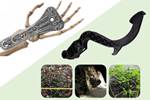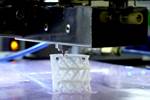Post Cure: Natural mineral fiber biocomposite via AFP enhances implant integration
Arctic Biomaterials produces high-quality composite biomaterials incorporating a natural mineral fiber that is useful in medical and healthcare-related fields.
Source | Arctic Biomaterials
What if composite materials could be bioresorbable and biocompatible?
, also known as ABM Composite (Tampere, Finland), offers ultra-strong X3 biomaterials that when processed via automated fiber placement (AFP), have been reported to achieve more than 16,000 MPa flexural modulus and over 600 MPa in flexural strength, manifold to biocomposite PLGA + TCP and PDLLA alternatives.
Based on bioabsorbable polymers reinforced by the company’s natural mineral fibers, the bio-integrative and bioactive innovation provides a strong and osteoconductive ingredient to combine with bioresorbable polymers and other biomaterials.
While particularly well suited to medical devices, as demonstrated by this bioabsorbable bone fixation implant, the company notes the material is also applied in load-bearing components.
Arctic Biomaterials offers Evolvecomp X3 fiber pellet composites, as well as X3 continuous fiber composites. Ultimately, this provides Arctic Biomaterials’ customers a possibility to produce bioresorbable medical implants with high performance while also maintaining a balanced pH environment, which promotes bone formation and growth.
Related Content
-
European boatbuilders lead quest to build recyclable composite boats
Marine industry constituents are looking to take composite use one step further with the production of tough and recyclable recreational boats. Some are using new infusible thermoplastic resins.
-
Airbus works to improve the life cycle of composites in future aircraft
This companion article to CW's September 2024 Airbus Illescas plant tour discusses recycling, LCA, biocomposites, Fast Track technologies, qualification and more.
-
Okom wrks labs works with Autodesk for mycelium-based composite commercialization
Research Residency program will further refine material properties and manufacturing processes to support the startup’s efforts of providing high-performance, regenerative biocomposite solutions.






